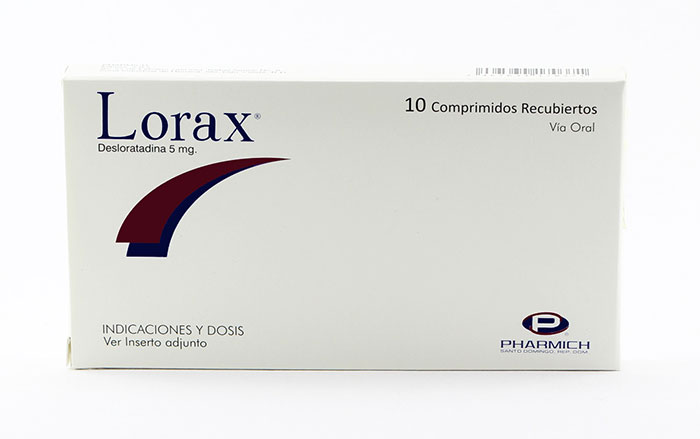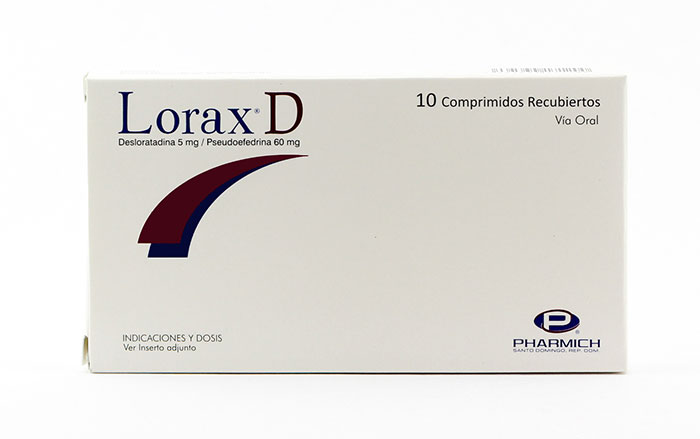[vc_row inner_container=»true» bg_color=»#ffffff» style=»margin-bottom:0px; padding-bottom:0px;»][vc_column alignment=»left» width=»1/2″]
Lorax

 [/vc_column][/vc_row][vc_row inner_container=»true» bg_color=»#ffffff» style=»margin-top:0px; margin-bottom:0px;»][vc_column width=»1/1″]
[/vc_column][/vc_row][vc_row inner_container=»true» bg_color=»#ffffff» style=»margin-top:0px; margin-bottom:0px;»][vc_column width=»1/1″]Actions
Lorax contains desloratadine, Lorax-D contains desloratadine plus pseudoephedrine. Desloratadine is a long-acting, non-sedating histamine antagonist with potent selective antagonist activity of peripheral histamine H1 receptors. Desloratadine has demonstrated antiallergic, antihistamine and anti-inflammatory activity. Pseudoephedrine hydrochloride is an oral vasoconstrictor, which causes a sustained gradual decongestant effect.
Clinical pharmacology
Pharmacodynamic properties:
Desloratadine: After oral administration, desloratadine selectively blocks peripheral histamine H1 receptors, because the agent is effectively excluded from entry into the central nervous system (CNS). In addition to antihistamine activity, desloratadine has shown antiallergic and anti-inflammatory activity in numerous studies.
Pseudoephedrine: acts on alpha-adrenergic receptors in the mucosa of the respiratory tract, causing vasoconstriction. It reduces tissue hyperemia, edema, and nasal congestion, and increases the permeability of the nasal airways.
Pharmacokinetic properties
Desloratadine: Its plasma concentrations can be detected within 30 minutes of administration. The agent is well absorbed, achieving maximum concentrations after approximately 3 hours; The terminal phase half-life is approximately 27 hours. The degree of accumulation of desloratadine corresponds to its half-life (approximately 27 hours) and a frequency of administration once a day. The bioavailability of desloratadine is proportional to the dose between the limits of 5 and 20 mg. Desloratadine is moderately conjugated (83% to 87%) with plasma proteins.
Pseudoephedrine: It is incompletely metabolized in the liver, it begins its action from 15 to 30 minutes; its action lasts 3 to 4 hours and in a long-acting capsule its effect is 8 to 12 hours. About 55 to 75% of a dose is excreted unchanged. The excretion rate increases in acidic urine.
[/vc_column][/vc_row][vc_row inner_container=»true» bg_color=»#ffffff» style=»margin-top:0px; margin-bottom:0px;»][vc_column width=»1/2″]
Indications
LORAX is indicated in: perennial and stationary allergic rhinitis, for day and night symptoms; urticaria, multiple allergic manifestations and as an adjunct in asthma and atopic dermatitis. The clinical efficacy of desloratadine is evaluated through relief of nasal (runny nose, itching, sneezing) and non-nasal symptoms (burning eyes, tearing, red eyes, itching of the ears or palate), all-day relief and night for allergy sufferers, with a single daily dose. Rapid onset of symptom relief, as well as improvement in quality of life.
LORAX-D: It is recommended when you want to obtain the antihistamine properties of desloratadine and the decongestant effects of pseudoephedrine hydrochloride.
Pharmacological interactions
No clinically relevant drug interactions with desloratadine were observed in clinical studies. Desloratadine taken concomitantly with alcohol does not enhance performance impairment effects due to alcohol. Pseudoephedrine: MAO inhibitors, Methyldopa, Reserpine.
Preclinical toxicology
Desloratadine is the main active metabolite of Loratadine. Preclinical studies conducted with desloratadine show that there are no qualitative or quantitative differences between the toxicity tables of desloratadine and loratadine, at similar levels of exposure to desloratadine. Desloratadine does not present a carcinogenic risk in man, based on available data, or mutagenic effects in vitro and in vivo mutagenesis studies. There is no overall effect on rat fertility, at an exposure 34 times greater than the human exposure resulting from administration at the recommended clinical dose. Pseudoephedrine: High or therapeutic doses in susceptible subjects are capable of causing nervous, cardiac and digestive disorders.
Side effects
In controlled and uncontrolled clinical studies, no clinically relevant drug-related adverse effects, including cardiovascular effects, were observed with desloratadine in 4% of patients over placebo. Excessive drowsiness was not reported. Headaches were reported in 2% of patients receiving desloratadine; in rare cases dry mouth and fatigue were reported (greater 1/1000, 1/100). Pseudoephedrine: Headache, dry mouth.
Contraindications
Hypersensitivity to desloratadine and pseudoephedrine or to any of the excipients in the product.
[/vc_column][vc_column width=»1/2″ style=»background-color:#f4f4f4; height:100%; padding-left:10px; padding-right:10px;»]
Composition
Lorax syrup: each 5 ml contains desloratadine 2.5mg
Lorax coated tablets: each tablet contains desloratadine 5mg
Lorax-D syrup: each 5ml contains desloratadine 2.5mg + pseudoephedrine 30mg
Lorax-D coated tablets: each tablet contains desloratadine 5mg + pseudoephedrine 60mg
Administration route
Oral
Posology
Adults and adolescents (over 12 years of age): one tablet or 10 ml of the syrup, once a day, regardless of food. Children between 6 and 11 years old: 5 ml once a day with or without meals. Children between 2 and 5 years: 2.5 ml of syrup once a day, with or without meals.
Presentation
Lorax Syrup: Box containing a bottle with 60ml of syrup with a measuring cup.
Lorax Coated Tablets: Box containing a blister with 10 coated tablets.
Lorax-D Syrup: Box containing a bottle with 60ml of syrup with a measuring cup.
Lorax-D Coated Tablets: Box containing a blister with 10 coated tablets.
Storage Recommendations
Store below 30 °C. Protect yourself from light and moisture.
Drug Interactions
No clinically relevant drug interactions with desloratadine are observed in clinical studies. Desloratadine taken in conjunction with alcohol does not potentiate the performance impairing effects of alcohol. Pseudoephedrine: MAO inhibitors, Methyldopa, Reserpine.
[/vc_column][/vc_row]
